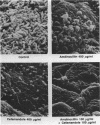Abstract
Antibiotics are generally not effective against organisms in exopolysaccharide biofilms. A simple method of studying the effect of antibiotics on bacteria in established biofilms is reported. Escherichia coli ATCC 25922 cells grown overnight at 37 degrees C on Mueller-Hinton agar were suspended in buffer and dispensed on 0.5-cm2 catheter disks. The disks were incubated for 1 h at 37 degrees C, washed, transferred to petri dishes containing 20 ml of broth, and incubated at 37 degrees C for 20 to 22 h, at which time thick biofilms were established. Disks were washed, placed in broth or broth containing antibiotic, and incubated at 37 degrees C for 4 h. The disks were removed, and viable counts were determined. This process was repeated at other selected time intervals (e.g., 8 and 24 h). Viable bacterial counts decreased from 10(3) to 10(4) CFU/cm2 in 24 h with 400 micrograms of amdinocillin or cefamandole per ml. A combination containing 400 micrograms of each antibiotic per ml decreased the viable counts to an undetectable level (less than 100 CFU/cm2) in 24 h. Other antibiotics and organisms were also examined in this system.
Full text
PDF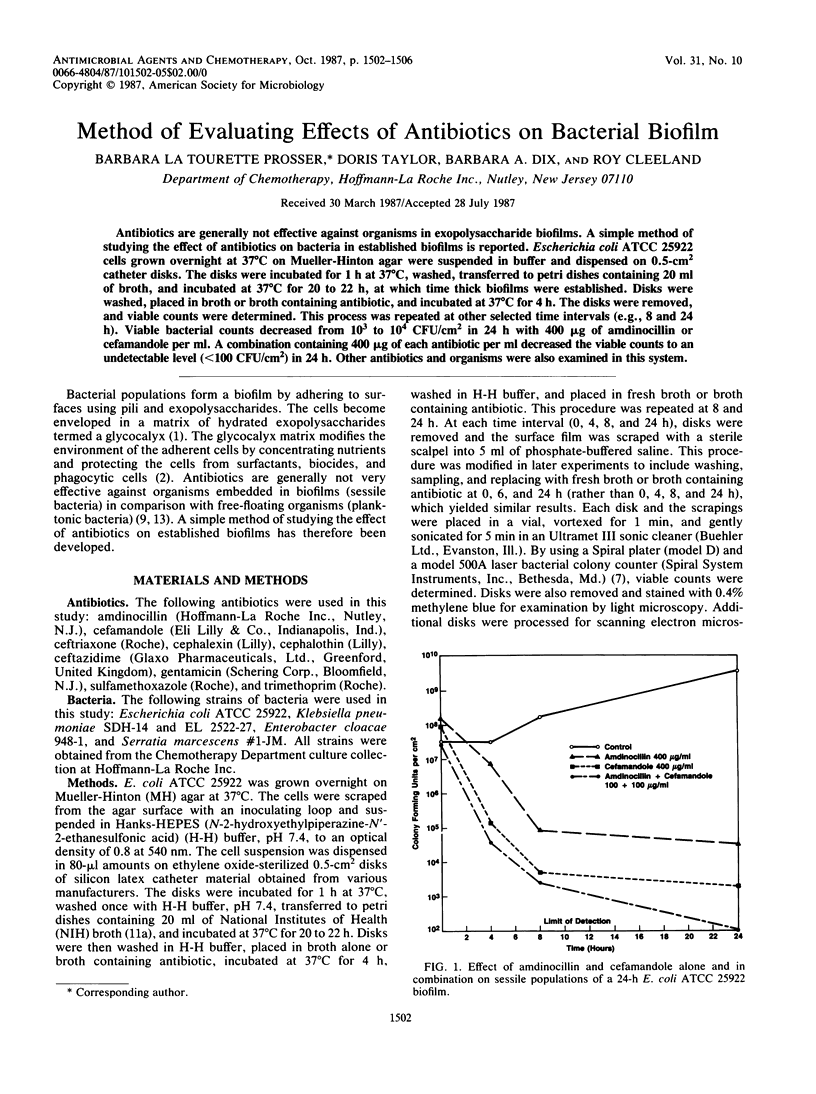
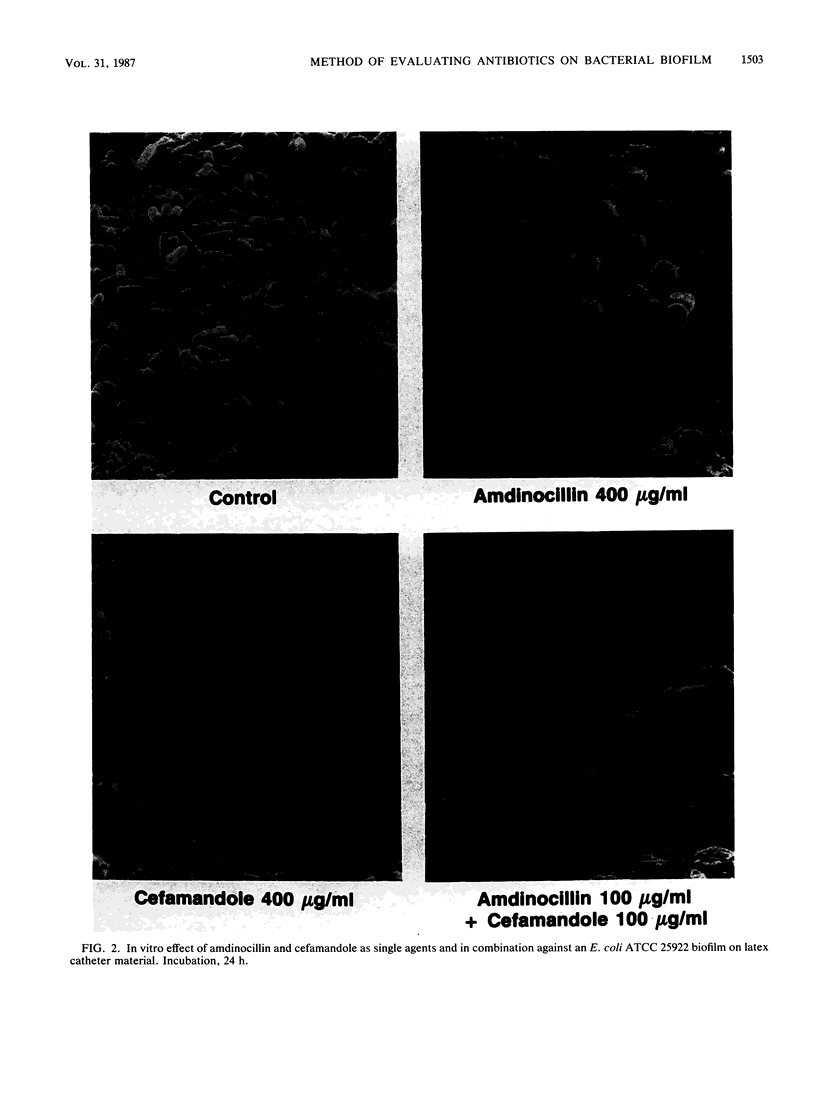
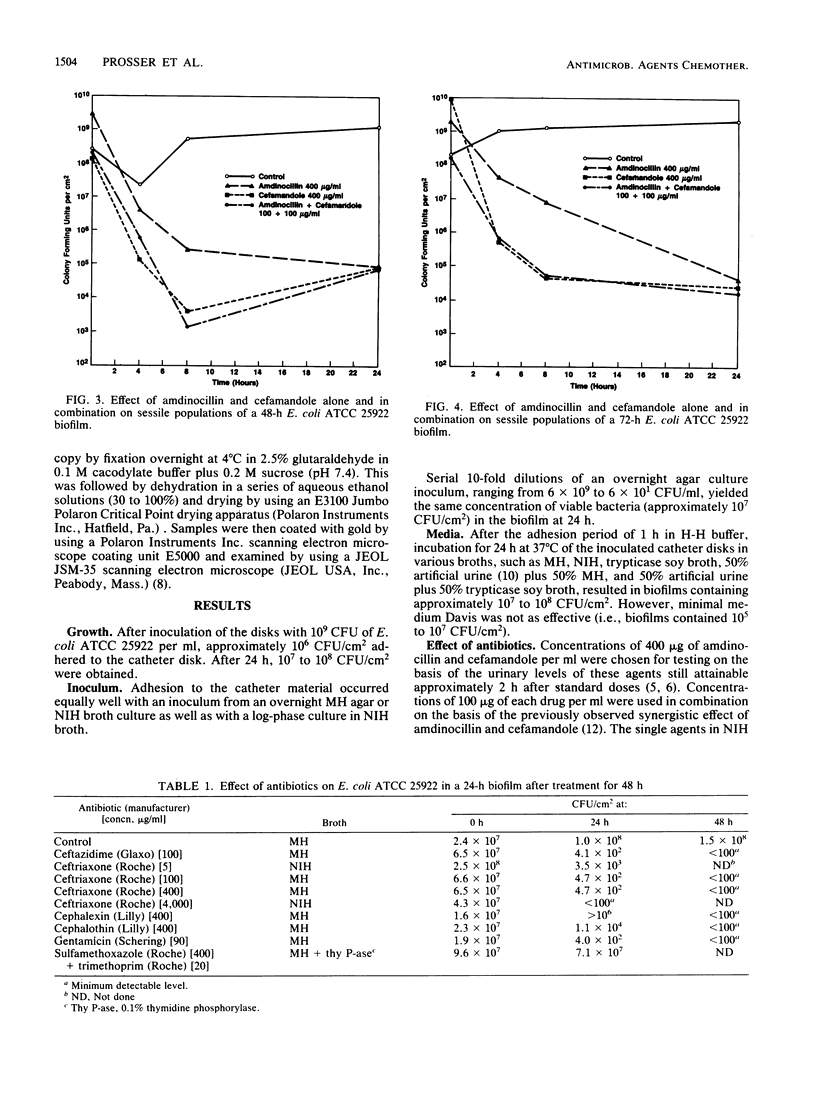
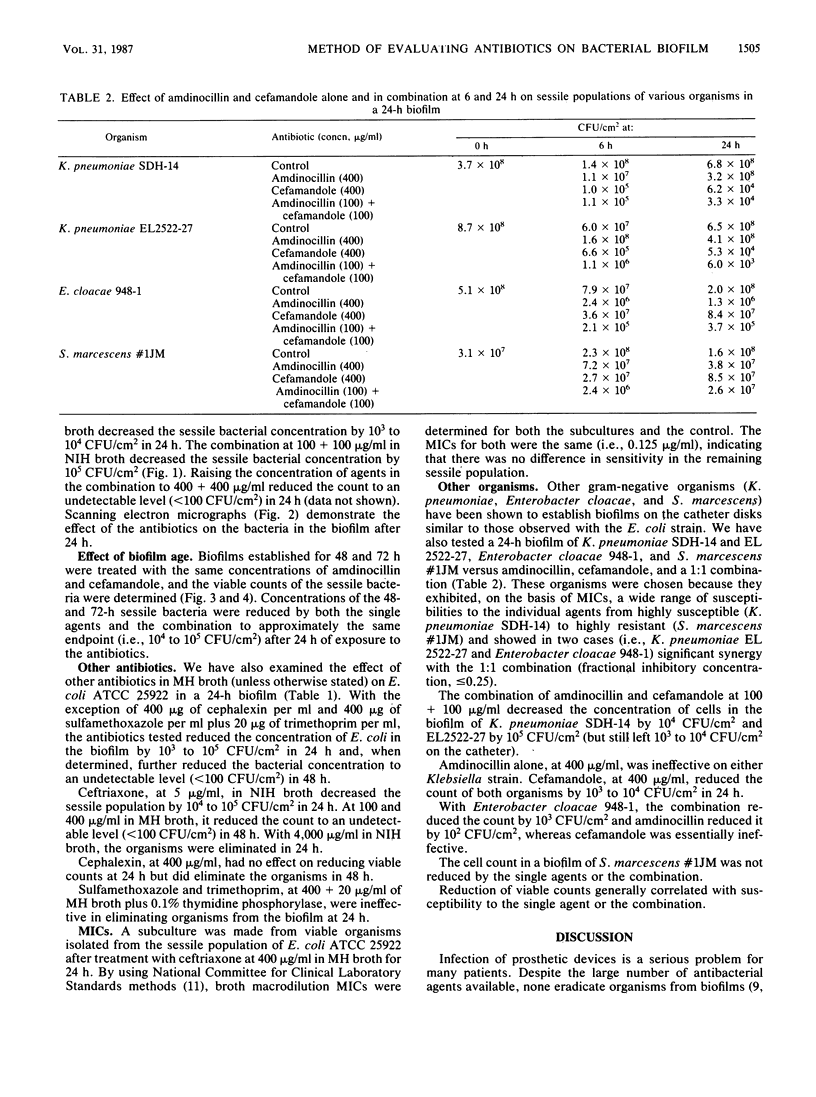
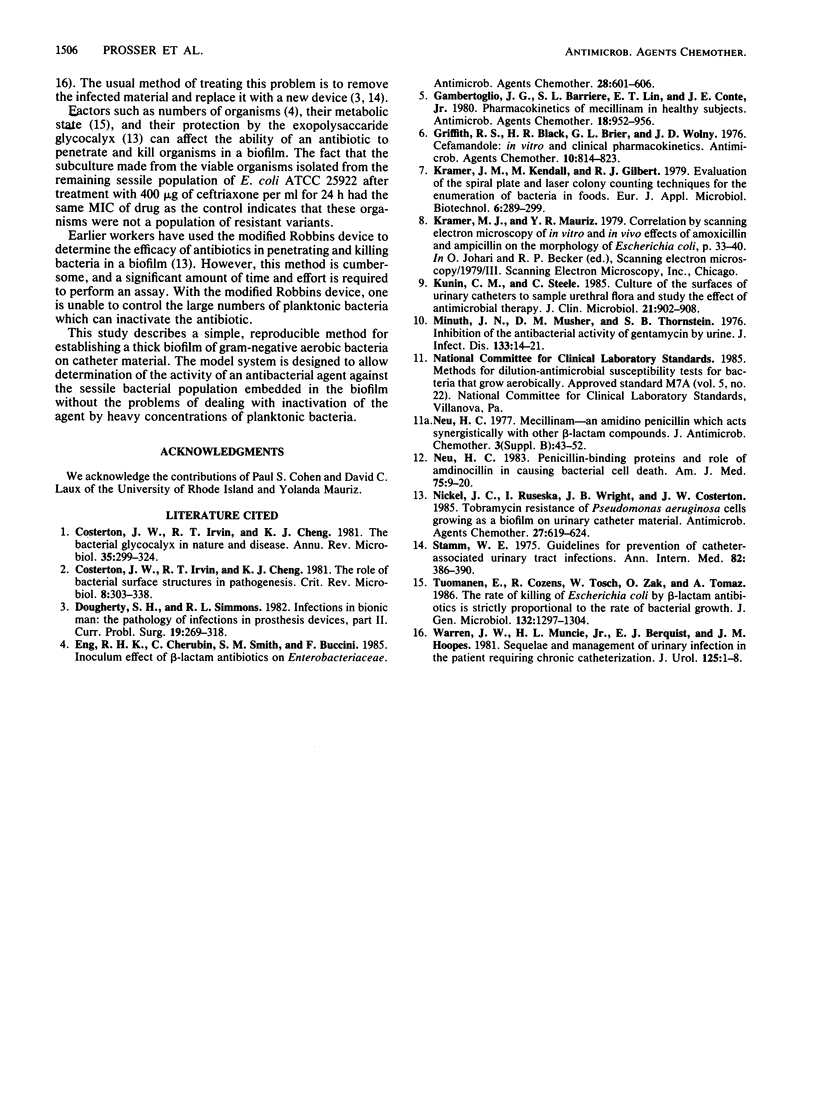
Images in this article
Selected References
These references are in PubMed. This may not be the complete list of references from this article.
- Costerton J. W., Irvin R. T., Cheng K. J. The bacterial glycocalyx in nature and disease. Annu Rev Microbiol. 1981;35:299–324. doi: 10.1146/annurev.mi.35.100181.001503. [DOI] [PubMed] [Google Scholar]
- Costerton J. W., Irvin R. T., Cheng K. J. The role of bacterial surface structures in pathogenesis. Crit Rev Microbiol. 1981;8(4):303–338. doi: 10.3109/10408418109085082. [DOI] [PubMed] [Google Scholar]
- Eng R. H., Cherubin C., Smith S. M., Buccini F. Inoculum effect of beta-lactam antibiotics on Enterobacteriaceae. Antimicrob Agents Chemother. 1985 Nov;28(5):601–606. doi: 10.1128/aac.28.5.601. [DOI] [PMC free article] [PubMed] [Google Scholar]
- Gambertoglio J. G., Barriere S. L., Lin E. T., Conte J. E., Jr Pharmacokinetics of mecillinam in health subjects. Antimicrob Agents Chemother. 1980 Dec;18(6):952–956. doi: 10.1128/aac.18.6.952. [DOI] [PMC free article] [PubMed] [Google Scholar]
- Griffith R. S., Black H. R., Brier G. L., Wolny J. D. Cefamandole: in vitro and clinical pharmacokinetics. Antimicrob Agents Chemother. 1976 Nov;10(5):814–823. doi: 10.1128/aac.10.5.814. [DOI] [PMC free article] [PubMed] [Google Scholar]
- Kramer M. J., Mauriz V. R. Correlation by scanning electron microscopy of in vitro and in vivo effects of amoxicillin and ampicillin on the morphology of Escherichia coli. Scan Electron Microsc. 1979;(3):33–40. [PubMed] [Google Scholar]
- Kunin C. M., Steele C. Culture of the surfaces of urinary catheters to sample urethral flora and study the effect of antimicrobial therapy. J Clin Microbiol. 1985 Jun;21(6):902–908. doi: 10.1128/jcm.21.6.902-908.1985. [DOI] [PMC free article] [PubMed] [Google Scholar]
- Minuth J. N., Musher D. M., Thorsteinsson S. B. Inhibition of the antibacterial activity of gentamicin by urine. J Infect Dis. 1976 Jan;133(1):14–21. doi: 10.1093/infdis/133.1.14. [DOI] [PubMed] [Google Scholar]
- Neu H. C. Mecillinam--an amidino penicillin which acts synergistically with other beta-lactam compounds. J Antimicrob Chemother. 1977 Jul;3 (Suppl B):43–52. doi: 10.1093/jac/3.suppl_b.43. [DOI] [PubMed] [Google Scholar]
- Neu H. C. Penicillin-binding proteins and role of amdinocillin in causing bacterial cell death. Am J Med. 1983 Aug 29;75(2A):9–20. doi: 10.1016/0002-9343(83)90089-x. [DOI] [PubMed] [Google Scholar]
- Nickel J. C., Ruseska I., Wright J. B., Costerton J. W. Tobramycin resistance of Pseudomonas aeruginosa cells growing as a biofilm on urinary catheter material. Antimicrob Agents Chemother. 1985 Apr;27(4):619–624. doi: 10.1128/aac.27.4.619. [DOI] [PMC free article] [PubMed] [Google Scholar]
- Stamm W. E. Guidelines for prevention of catheter-associated urinary tract infections. Ann Intern Med. 1975 Mar;82(3):386–390. doi: 10.7326/0003-4819-82-3-386. [DOI] [PubMed] [Google Scholar]
- Tuomanen E., Cozens R., Tosch W., Zak O., Tomasz A. The rate of killing of Escherichia coli by beta-lactam antibiotics is strictly proportional to the rate of bacterial growth. J Gen Microbiol. 1986 May;132(5):1297–1304. doi: 10.1099/00221287-132-5-1297. [DOI] [PubMed] [Google Scholar]
- Warren J. W., Muncie H. L., Jr, Bergquist E. J., Hoopes J. M. Sequelae and management of urinary infection in the patient requiring chronic catheterization. J Urol. 1981 Jan;125(1):1–8. doi: 10.1016/s0022-5347(17)54874-0. [DOI] [PubMed] [Google Scholar]



